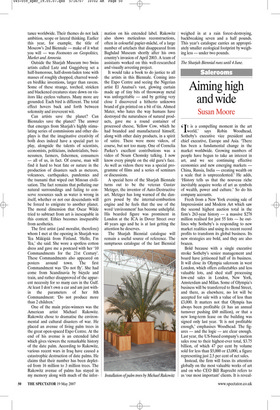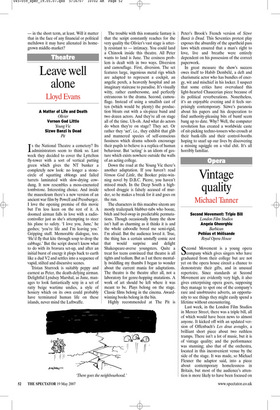Aiming high and wide
Susan Moore
‘t is a compelling moment in the art Iworld,’ says Robin Woodhead, Sotheby’s executive vice president and chief executive, Europe and Asia. ‘There has been a fundamental change in the market worldwide. Growing numbers of people have begun to take an interest in art, and we see continuing effective economies and new emerging markets China, Russia, India — creating wealth on a scale that is unprecedented.’ He adds, ‘History tells us that the nouveau riche inevitably acquire works of art as symbols of wealth, power and culture.’ So do his company accounts.
Fresh from a New York evening sale of Impressionist and Modern Art which saw the second highest auction total in the firm’s 263-year history — a massive $278 million realised for just 55 lots — he outlines why Sotheby’s is responding to new market realities and using its recent record profits to transform its global business. Its new strategies are bold, and they are also brazen.
Bold because with a single executive stroke Sotheby’s senior management and board have jettisoned half of its business. It will close its Olympia saleroom in west London, which offers collectables and less valuable lots, and shed staff processing low-end sales in London, New York, Amsterdam and Milan. Some of Olympia’s business will be transferred to Bond Street, and there, as elsewhere, no lot will be accepted for sale with a value of less than £3,000. It matters not that Olympia has always been profitable (it has an annual turnover pushing £60 million), or that a new long-term lease on the building was signed only last year. ‘It is not profitable enough,’ emphasises Woodhead. The figures — and the logic — are clear enough. Last year, the US-based company’s auction sales rose to their highest-ever total, $3.75 billion, of which 47 per cent by volume sold for less than $5,000 or £3,000, a figure representing just 2.5 per cent of net sales.
Instead, the firm will focus its attention globally on the most valuable works of art and on who CEO Bill Ruprecht refers to as ‘our most important’ clients. It is reveal ing that its dramatically enhanced allsinging all-dancing website, mySothebys, a 24-hour service which Woodhead describes as ‘a revolution in the marketplace comparable to online banking’ and which is to be launched next month, is available by invitation only. To service client relationships perhaps I should say establish them, given that up to 20 per cent of lots in recent major sales have been going to buyers hitherto unknown to the auction houses more offices and new staff are popping up all over (there are already 98 offices worldwide).
As I write, a new office opens in Beijing and another in Moscow next week. A ‘memo of understanding’ has been signed with Abu Dhabi (Christie’s is already staging sales in Dubai). Its educational arm, Sotheby’s Institute of Art, is opening premises in Singapore. Closer to home, the firm is expanding in Paris and recently acquired Calmels Cohen, a French auction house specialising in Impressionist, modern, contemporary and tribal art.
Woodhead insists that Sotheby’s will remain a ‘full-service’ operation — the firm currently offers 70 categories of sales. Art will also continue to remain its core business. That said, the auction house is busy once again extending its brand to other luxury goods and services — it has long been involved in real estate and finance. Last year it went into partnership to found Sotheby’s Diamonds; last month it launched a new ‘world elite’ credit card. ‘We are leaving it to others to be the supermarkets of the art business,’ says Woodhead.
Those ‘supermarkets’ include arch-rivals and current market leaders Christie’s. Despite recently culling some of its sales of collectibles at South Kensington — most of the business of selling toys, trains, teddy bears, cameras and the like had moved online anyway — Christie’s remains committed to its secondary London saleroom and to selling works of art across the board. In fact, it is investing significant sums improving the facility. ‘We believe that the “retail” market, which we have developed through our Interiors sales at South Kensington and in New York, is an important means of introducing clients to our business,’ explains Lisa King, Christie’s international managing director. ‘It also seems that our clients want to shop with us from top to bottom.’ It also allows them the convenience of selling across the board too. She adds, ‘The retail and middle-markets are very profitable to us. As they are less volatile, they act as a fantastic buffer and provide a very solid return. They offer a strong foundation for competing at the top end.’ The top end, of course, provides the greatest profits but also the highest risks. This month’s New York Impressionist, Modern and contemporary sales saw Sotheby’s raise the stakes significantly in the cut-throat business of securing the best works of art for auction by offering possible vendors staggeringly high guarantees — sums paid regardless of whether a work sells or not — as well as promising percentages of the buyer’s premium. It seems likely that this strategy of aiming high and focusing on its richest clients will pay off — in the short term, at least. Will it matter that in the face of any financial or political meltdown it may have alienated its homegrown middle-market?












































































 Previous page
Previous page